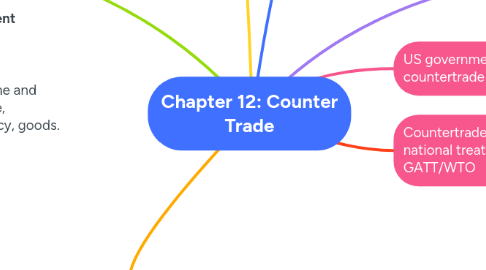
1. Barter-type
1.1. Simple barter
1.1.1. Direct exchange g&s for g&s, difficult in value measure.
1.2. Switch trading
1.2.1. Have third party, buy countertraded product for hard currency
1.3. Clearing arrangement
1.3.1. 2 government set credit line and clear account. If imbalance, settlement by hard currency, goods.
2. Definition
2.1. exporters accept in partial or total settlement of their deliveries a supply of products from the importing country.
2.2. 20-30% world trade
3. Parallel transaction
3.1. Buy-back
3.1.1. Exports sell technology, plant... and promise to buy output of the technology. 21% countertrade
3.1.1.1. Few years to 30 yrs
3.1.1.1.1. Required protection of patents, trademark...
3.2. Counter- purchase
3.2.1. Goods are not same, 54% counter trade
3.2.1.1. 3-5 yrs
3.2.1.1.1. Require reciprocal purchase of less than original sales
3.3. Off-sets
3.3.1. Direct offset
3.3.1.1. **Coproduction:** joint venture, output fulfills parts of the sale obligation
3.3.1.2. **Subcontractor:** production of a part or component of the manufacturer’s export article. does not often involve licensing of technological information.
3.3.1.3. **Overseas investments:** capital investment to establish a company
3.3.1.4. **Technology transfer:** technical assistance, R&D capabilities.
3.3.2. Indirect offset
3.3.2.1. g&s unrelated to the exports are acquired from or produced in the host
4. When
4.1. Lack funds, scare hard currency reserves
4.2. sustain export price when demand declining
4.3. Export countries have limited marketability in foreign market
5. Benefits
5.1. Buyer
5.1.1. Transfer technology
5.1.2. Alleviation the balance of payment difficulties
5.1.3. Sustain price, market access
5.2. Seller
5.2.1. increases sales
5.2.2. assess supply
5.2.3. Flexibility in prices
